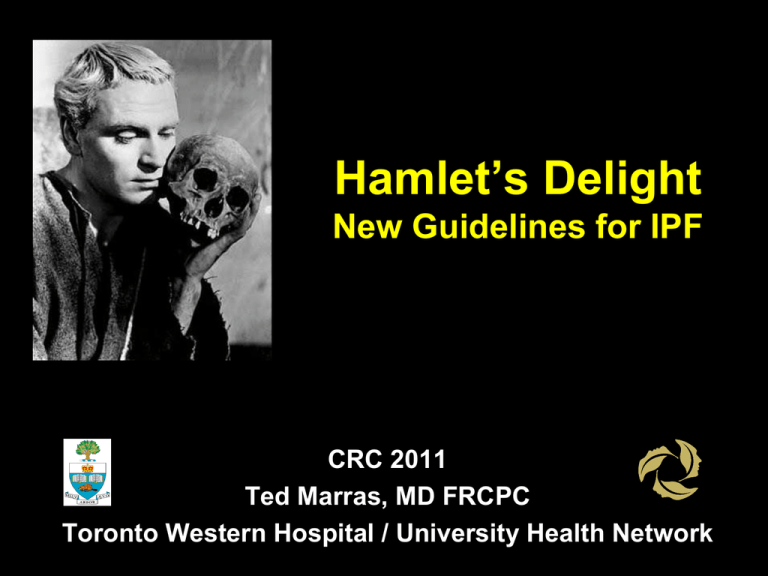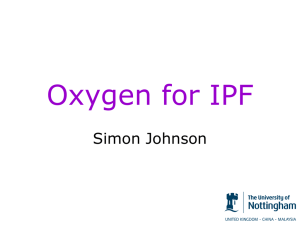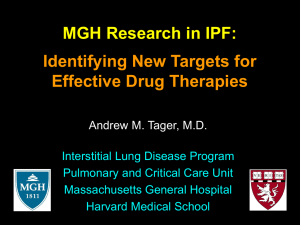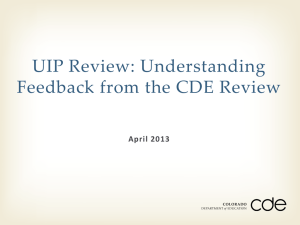New Guidelines for IPF
advertisement

Hamlet’s Delight New Guidelines for IPF CRC 2011 Ted Marras, MD FRCPC Toronto Western Hospital / University Health Network Declarations Potential conflicts of interest Financial – Study participation: Actelion, BoehringerIngelheim, Gilead, Intermune – Grant support: CPFF, CIHR Other – Clinical and academic interest in ILD Off label use of therapies None of the medications mentioned have a formal indication for treating IPF Objectives Considering revised guidelines for idiopathic pulmonary fibrosis (IPF): 1. Consider appropriate investigations and diagnostic algorithm for IPF 2. Select a management strategy that is most appropriate for a given IPF patient 3. Select an appropriate strategy of clinical follow-up for a given IPF patient IPF What is it? • Chronic, progressive fibrosis of the lung • Unknown cause Why is it bad? • Stiff lung dyspnea • Scarred lung poor gas exchange • Poor prognosis (difficult to quantify) IPF - HRCT Peripheral, basal predominant: • Reticulations, interlobular septal thickening, intralobular reticulations • Honeycombing IPF - Histology = UIP A) Heterogeneity, traction emphysema B) Subpleural fibrosis, fibroblast foci C) Fibroblast focus D) Microscopic honeycombing Raghu. Clin Chest Med 2004. 25(4)621-36. IPF - Natural history Raghu AJRCCM 183.788-824. 2011 ATS / ERS / JRS / ALAT Provide evidence- based recommendations on diagnosis and management of IPF Joint Taskforce • 22 Pulmonary physicians • • • • 4 Chest radiologists 4 Lung pathologists 3 Health care librarians 1 Expert methodologist (respirologist) Raghu et al. AJRCCM 2011, 183:788-824 Recommendations Reviewed published data Recommendations on questions • Direction – yes / no • Strength – strong / weak • Evidence quality Voted on by committee members Recommendations Raghu et al. AJRCCM 2011, 183:788-824 Recommendations Raghu et al. AJRCCM 2011, 183:788-824 Objectives Considering revised guidelines for idiopathic pulmonary fibrosis (IPF): 1. Consider appropriate investigations and diagnostic algorithm for IPF 2. Select a management strategy that is most appropriate for a given IPF patient 3. Select an appropriate strategy of clinical follow-up for a given IPF patient Diagnosis Excluding Connective Tissue Disease • Should a CTD serologic evaluation be performed in all people with suspected IPF? • No reliable data Diagnosis Excluding Connective Tissue Disease • Should a CTD serologic evaluation be performed in all people with suspected IPF? • No reliable data Recommendation Question CTD serology? Direction Strength Evidence quality Yes Weak Very low Vote Yes/No/Abs 23/0/0 Even in absence of overt CTD: RF, anti-CCP, ANA (ENA – Jo-1, Scl-70, etc. may be helpful) Diagnosis Utility of BAL / TBBx • BAL may help differentiate HP • TBBx may help with granulomatous disorders • Should BAL / TBBx be performed in all people with suspected IPF? Diagnosis Utility of BAL / TBBx • BAL may help differentiate HP • TBBx may help with granulomatous disorders • Should BAL / TBBx be performed in all people with suspected IPF? Recommendation Question Vote Yes/No/Abs Direction Strength Evidence quality BAL? No Weak Low 4/18/1 TBBx? No Weak Low 0/23/0 Diagnosis Multi-disciplinary discussion (MDD) • IPF diagnosis usually requires expertise from clinicians, radiologists, pathologists • Proper communication increases inter-observer agreement • Should MDD be used in evaluating suspected IPF? Diagnosis Multi-disciplinary discussion (MDD) • IPF diagnosis usually requires expertise from clinicians, radiologists, pathologists • Proper communication increases inter-observer agreement • Should MDD be used in evaluating suspected IPF? Recommendation Question MDD? Direction Strength Evidence quality Yes Strong Low Vote Yes/No/Abs 0/23/0 • Not possible for many practitioners • Efforts to promote verbal communication should be made Diagnosis Consider: • Clinical • Radiology - HRCT • Histology - surgical lung biopsy Diagnosis HRCT Relevant features 1. Distribution subpleural / basal predominant 2. Reticulation 3. Honeycombing + traction bronchiectasis 4. Absence of inconsistent features: – – – – – – – Upper lobe predominant Peribronchial predominant GGO > reticulation Profuse micronodules Discrete cysts – multiple, bilateral, away from HC Diffuse mosaicism Consolidation Diagnosis HRCT HRCT classification for suspected IPF • UIP pattern (1,2,3,4) • Possible UIP pattern (1,2,4) • Inconsistent with UIP (4 not fulfilled) 1. 2. 3. 4. Subpleural / basal Reticulation Honeycombing + traction bronchiectasis Absence of inconsistent features Diagnosis Histology Relevant features 1. Fibrosis + subpleural / paraseptal HC 2. Patchy 3. Fibroblast foci 4. Absence of inconsistent features: – – – – – Hyaline membranes Organizing pneumonia Granulomas Marked inflammation away from HC Predominantly airway centred Diagnosis Histology Histologic classification for suspected IPF • UIP pattern (1,2,3,4) • Probable UIP pattern (1 and [2 or 3] and 4) or HC only • Possible UIP pattern (1,4) • Not UIP pattern (4 not fulfilled) 1. 2. 3. 4. Fibrosis + subpleural / paraseptal HC Patchy Fibroblast foci Absence of inconsistent features Diagnosis HRCT / Histology HRCT Surgical biopsy IPF? UIP Not done (clinically typical) UIP / Probable / Possible Not UIP Yes Yes No Consistent with UIP (lack HC / traction bronchiectasis) UIP / Probable Possible UIP Not UIP Yes Probable* No Inconsistent with UIP (inconsistent features) UIP All others Possible* No * Multidisciplinary discussion recommended Diagnosis HRCT / Histology HRCT Surgical biopsy IPF? UIP Not done (clinically typical) Not UIP Yes Yes No Consistent with UIP (lack HC / traction bronchiectasis) UIP / Probable Possible UIP Not UIP Yes Probable* No Inconsistent with UIP (inconsistent features) UIP All others Possible* No * Multidisciplinary discussion recommended Diagnosis HRCT / Histology HRCT Surgical biopsy IPF? UIP Not done (clinically typical) UIP / Probable / Possible Not UIP Yes Yes Consistent with UIP (lack HC / traction bronchiectasis) UIP / Probable Possible UIP Not UIP Yes Probable* No Inconsistent with UIP (inconsistent features) UIP All others Possible* No * Multidisciplinary discussion recommended Diagnosis HRCT / Histology HRCT Surgical biopsy IPF? UIP Not done (clinically typical) UIP / Probable / Possible Not UIP Yes Yes No Consistent with UIP (lack HC / traction bronchiectasis) UIP / Probable Possible UIP Not UIP Yes Probable* No Inconsistent with UIP (inconsistent features) UIP All others Possible* No * Multidisciplinary discussion recommended Diagnosis HRCT / Histology HRCT Surgical biopsy IPF? UIP Not done (clinically typical) UIP / Probable / Possible Not UIP Yes Yes No Possible UIP (lack HC) UIP / Probable Possible UIP Not UIP Yes Probable* No Inconsistent with UIP (inconsistent features) UIP All others Possible* No * Multidisciplinary discussion recommended Diagnosis HRCT / Histology HRCT Surgical biopsy IPF? UIP Not done (clinically typical) UIP / Probable / Possible Not UIP Yes Yes No Possible UIP (lack HC) UIP / Probable Possible UIP Not UIP Yes Probable* No Inconsistent with UIP (inconsistent features) UIP All others Possible* No * Multidisciplinary discussion recommended Diagnosis HRCT / Histology HRCT Surgical biopsy IPF? UIP Not done (clinically typical) UIP / Probable / Possible Not UIP Yes Yes No Possible UIP (lack HC) UIP / Probable Possible UIP Not UIP Yes Probable* No Inconsistent with UIP (inconsistent features) UIP All others Possible* No * Multidisciplinary discussion recommended Diagnosis HRCT / Histology HRCT Surgical biopsy IPF? UIP Not done (clinically typical) UIP / Probable / Possible Not UIP Yes Yes No Possible UIP (lack HC) UIP / Probable Possible UIP Not UIP Yes Probable* No Inconsistent with UIP (inconsistent features) UIP All others Possible* No * Multidisciplinary discussion recommended Diagnosis HRCT / Histology HRCT Surgical biopsy IPF? UIP Not done (clinically typical) UIP / Probable / Possible Not UIP Yes Yes No Possible UIP (lack HC) UIP / Probable Possible UIP Not UIP Yes Probable* No Inconsistent with UIP (inconsistent features) UIP All others Possible* No * Multidisciplinary discussion recommended Diagnosis HRCT / Histology HRCT Surgical biopsy IPF? UIP Not done (clinically typical) UIP / Probable / Possible Not UIP Yes Yes No Possible UIP (lack HC) UIP / Probable Possible UIP Not UIP Yes Probable* No Inconsistent with UIP (inconsistent features) UIP All others Possible* No * Multidisciplinary discussion recommended Diagnosis Suspected IPF Identifiable cause? yes Not IPF Diagnosis Suspected IPF Identifiable cause? no HRCT UIP IPF yes Not IPF Diagnosis Suspected IPF Identifiable cause? yes no HRCT possible UIP or inconsistent with UIP UIP Surgical Biopsy IPF Not IPF Diagnosis Suspected IPF Identifiable cause? yes Not IPF no HRCT possible UIP or inconsistent with UIP UIP Surgical Biopsy IPF Not UIP Diagnosis Suspected IPF Identifiable cause? yes Not IPF no HRCT possible UIP or inconsistent with UIP UIP Surgical Biopsy IPF Not UIP UIP, probable, possible See table Objectives Considering revised guidelines for idiopathic pulmonary fibrosis (IPF): 1. Consider appropriate investigations and diagnostic algorithm for IPF 2. Select a management strategy that is most appropriate for a given IPF patient 3. Select an appropriate strategy of clinical follow-up for a given IPF patient IPF Treatment Recommendation Treatment Vote Yes/No/Abs Direction Strength Evidence quality Steroids alone No Strong Very low 0 / 21 / 2 Colchicine No Strong Very low 0 / 21 / 2 Cyclosporine No Strong Very low 0 / 18 / 4 Steroid + Aza / CY No Strong Low 0 / 21 / 2 Steroid + Aza + NAC No Weak Low 3 / 17 / 3 NAC alone No Weak Low 5 / 15 / 3 IFN gamma No Strong High 0 / 17 / 6 Bosentan No Strong Moderate 0 / 10 / 13 Etanercept No Strong Moderate 0 / 18 / 4 Anticoagulation No Weak Very low 1 / 20 / 2 Pirfenidone No Weak Low-mod 4 / 10 / 17 IPF Treatment Recommendation Treatment Vote Yes/No/Abs Direction Strength Evidence quality Steroids alone No Strong Very low 0 / 21 / 2 Colchicine No Strong Very low 0 / 21 / 2 Cyclosporine No Strong Very low 0 / 18 / 4 Steroid + Aza / CY No Strong Low 0 / 21 / 2 Steroid + Aza + NAC No Weak Low 3 / 17 / 3 NAC alone No Weak Low 5 / 15 / 3 IFN gamma No Strong High 0 / 17 / 6 Bosentan No Strong Moderate 0 / 10 / 13 Etanercept No Strong Moderate 0 / 18 / 4 Anticoagulation No Weak Very low 1 / 20 / 2 Pirfenidone No Weak Low-mod 4 / 10 / 17 IPF Treatment Recommendation Treatment Vote Yes/No/Abs Direction Strength Evidence quality Steroids alone No Strong Very low 0 / 21 / 2 Colchicine No Strong Very low 0 / 21 / 2 Cyclosporine No Strong Very low 0 / 18 / 4 Steroid + Aza / CY No Strong Low 0 / 21 / 2 Steroid + Aza + NAC* No Weak Low 3 / 17 / 3 NAC alone No Weak Low 5 / 15 / 3 IFN gamma No Strong High 0 / 17 / 6 Bosentan No Strong Moderate 0 / 10 / 13 Etanercept No Strong Moderate 0 / 18 / 4 Anticoagulation No Weak Very low 1 / 20 / 2 Pirfenidone No Weak Low-mod 4 / 10 / 17 * Small physiologic benefit, may have significant toxicities IPF Treatment Recommendation Treatment Vote Yes/No/Abs Direction Strength Evidence quality Steroids alone No Strong Very low 0 / 21 / 2 Colchicine No Strong Very low 0 / 21 / 2 Cyclosporine No Strong Very low 0 / 18 / 4 Steroid + Aza / CY No Strong Low 0 / 21 / 2 Steroid + Aza + NAC No Weak Low 3 / 17 / 3 NAC alone* No Weak Low 5 / 15 / 3 IFN gamma No Strong High 0 / 17 / 6 Bosentan No Strong Moderate 0 / 10 / 13 Etanercept No Strong Moderate 0 / 18 / 4 Anticoagulation No Weak Very low 1 / 20 / 2 Pirfenidone No Weak Low-mod 4 / 10 / 17 * Limited data, safe, maybe cheap; preparation not standardized IPF Treatment Recommendation Treatment Vote Yes/No/Abs Direction Strength Evidence quality Steroids alone No Strong Very low 0 / 21 / 2 Colchicine No Strong Very low 0 / 21 / 2 Cyclosporine No Strong Very low 0 / 18 / 4 Steroid + Aza / CY No Strong Low 0 / 21 / 2 Steroid + Aza + NAC No Weak Low 3 / 17 / 3 NAC alone No Weak Low 5 / 15 / 3 IFN gamma No Strong High 0 / 17 / 6 Bosentan No Strong Moderate 0 / 10 / 13 Etanercept No Strong Moderate 0 / 18 / 4 Anticoagulation* No Weak Very low 1 / 20 / 2 Pirfenidone No Weak Low-mod 4 / 10 / 17 * Supportive study, several limitations IPF Treatment Recommendation Treatment Vote Yes/No/Abs Direction Strength Evidence quality Steroids alone No Strong Very low 0 / 21 / 2 Colchicine No Strong Very low 0 / 21 / 2 Cyclosporine No Strong Very low 0 / 18 / 4 Steroid + Aza / CY No Strong Low 0 / 21 / 2 Steroid + Aza + NAC No Weak Low 3 / 17 / 3 NAC alone No Weak Low 5 / 15 / 3 IFN gamma No Strong High 0 / 17 / 6 Bosentan No Strong Moderate 0 / 10 / 13 Etanercept No Strong Moderate 0 / 18 / 4 Anticoagulation No Weak Very low 1 / 20 / 2 Pirfenidone No Weak Low-mod 4 / 10 / 17 IPF Treatment Recommendation Treatment Vote Yes/No/Abs Direction Strength Evidence quality Steroids alone No Strong Very low 0 / 21 / 2 Colchicine No Strong Very low 0 / 21 / 2 Cyclosporine No Strong Very low 0 / 18 / 4 Steroid + Aza / CY No Strong Low 0 / 21 / 2 Steroid + Aza + NAC No Weak Low 3 / 17 / 3 NAC alone No Weak Low 5 / 15 / 3 IFN gamma No Strong High 0 / 17 / 6 Bosentan No Strong Moderate 0 / 10 / 13 Etanercept No Strong Moderate 0 / 18 / 4 Anticoagulation No Weak Very low 1 / 20 / 2 Pirfenidone No Weak Low-mod 4 / 10 / 17 IPF Treatment Recommendation Treatment Vote Yes/No/Abs Direction Strength Evidence quality Steroids alone No Strong Very low 0 / 21 / 2 Colchicine No Strong Very low 0 / 21 / 2 Cyclosporine No Strong Very low 0 / 18 / 4 Steroid + Aza / CY No Strong Low 0 / 21 / 2 Steroid + Aza + NAC No Weak Low 3 / 17 / 3 NAC alone No Weak Low 5 / 15 / 3 IFN gamma No Strong High 0 / 17 / 6 Bosentan No Strong Moderate 0 / 10 / 13 Etanercept No Strong Moderate 0 / 18 / 4 Anticoagulation No Weak Very low 1 / 20 / 2 Pirfenidone No Weak Low-mod 4 / 10 / 17 IPF Treatment Recommendation Treatment Vote Yes/No/Abs Direction Strength Evidence quality Steroids alone No Strong Very low 0 / 21 / 2 Colchicine No Strong Very low 0 / 21 / 2 Cyclosporine No Strong Very low 0 / 18 / 4 Steroid + Aza / CY No Strong Low 0 / 21 / 2 Steroid + Aza + NAC No Weak Low 3 / 17 / 3 NAC alone No Weak Low 5 / 15 / 3 IFN gamma No Strong High 0 / 17 / 6 Bosentan No Strong Moderate 0 / 10 / 13 Etanercept No Strong Moderate 0 / 18 / 4 Anticoagulation No Weak Very low 1 / 20 / 2 Pirfenidone No Weak Low-mod 4 / 10 / 17 “Nonpharmacologic” Treatment Recommendation Treatment Vote Yes/No/Abs Direction Strength Evidence quality Pulmonary rehabilitation Yes Weak Low 19 / 0 / 3 Oxygen Yes Strong Very low 18 / 0 / 4 Transplantation Yes Strong Low 21 / 0 / 1 Transplant Who to consider? Discuss at diagnosis Detailed evaluation: • Advanced at diagnosis • With objective deterioration Transplant Who to consider? Discuss at diagnosis Detailed evaluation: • Advanced at diagnosis • With objective deterioration Baseline Longitudinal • • • • • • • • Severe dyspnea DLCO<40% 6MW SaO2 < 88% Extensive HC on HRCT Increasing dyspnea FVC decrease >10%* DLCO decrease >15%* Progression on HRCT * Absolute measure Additional Treatment - Acute exacerbations AEIPF - Definition • “Acute, clinically significant deterioration of unidentifiable cause in a patient with underlying IPF” Diagnostic Criteria • IPF with unexplained worsening < 30 days • HRCT new bilateral GGO and/or consolidation superimposed on typical IPF pattern • No infection by tracheal aspirate or BAL • Exclude: CHF, PE, identifiable acute lung injury cause Additional Treatment Recommendation Treatment Vote Yes/No/Abs Direction Strength Evidence quality Steroids in AEIPF Yes Weak Very Low 14 / 5 / 1 Mechanical ventilation No Weak Low 2 / 19 / 1 Pulmonary hypertension No Weak Very low 8 / 14 / 1 Asymptomatic GERD Yes Weak Very low 15 / 8 / 0 Objectives Considering revised guidelines for idiopathic pulmonary fibrosis (IPF): 1. Consider appropriate investigations and diagnostic algorithm for IPF 2. Select a management strategy that is most appropriate for a given IPF patient 3. Select an appropriate strategy of clinical follow-up for a given IPF patient Monitoring for progression Routine PFT • Sustained change in absolute: – FVC of 10% (e.g. 2L1.8L)* – DLCO of 15% (Both associated with mortality, suggestive of progression) • *Smaller progressive, sustained changes MAY be relevant (e.g. 510% FVC decline) Monitoring for progression Routine PFT • Sustained change in absolute: – FVC of 10% (e.g. 2L1.8L) – DLCO of 15% (Both associated with mortality, suggestive of progression) 6MW distance / oximetry too variable over long time periods (good discriminative test, not a good evaluative test)

![[pptx » 4.5MB]](http://s2.studylib.net/store/data/005592894_1-3c6294153fdad9bfde35a24729aaf573-300x300.png)




